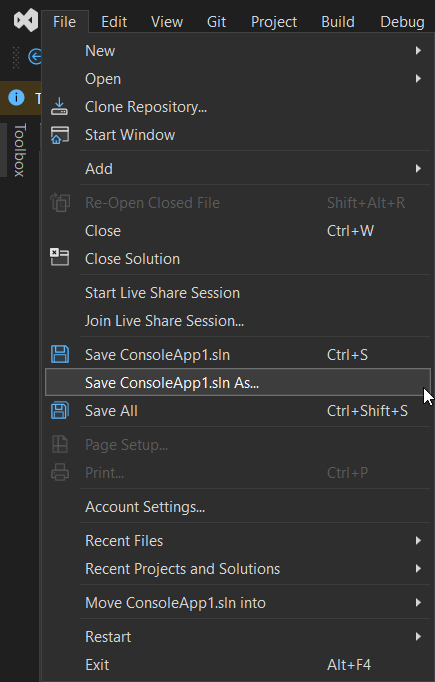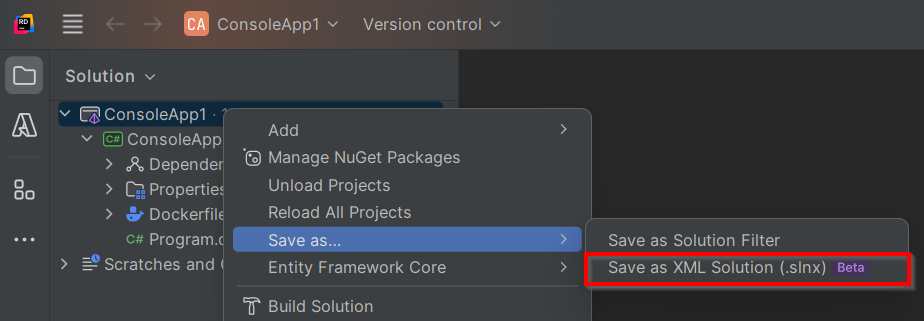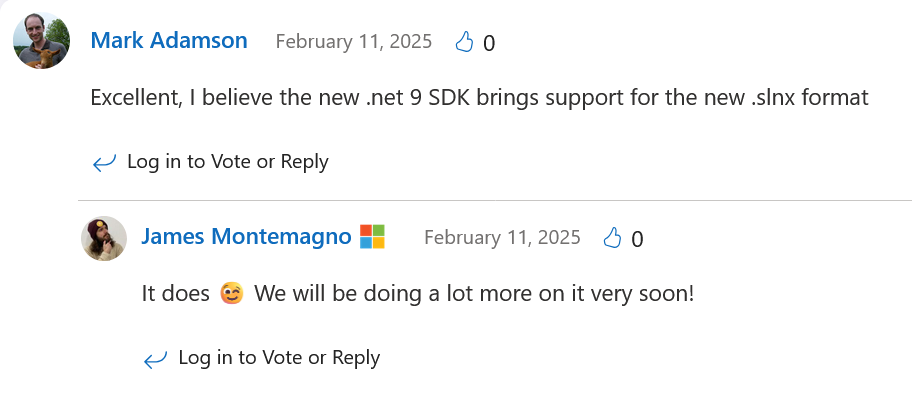The new XML based .NET solution file
Over are the days of the old .NET solution file format!
Why you ask? Because it looks like a mess:
Microsoft Visual Studio Solution File, Format Version 12.00
# Visual Studio Version 17
VisualStudioVersion = 17.13.35825.156
MinimumVisualStudioVersion = 10.0.40219.1
Project("{FAE04EC0-301F-11D3-BF4B-00C04F79EFBC}") = "ConsoleApp1", "ConsoleApp1\ConsoleApp1.csproj", "{B57133BE-05A9-40F6-9E8B-A9640044E781}"
EndProject
Global
GlobalSection(SolutionConfigurationPlatforms) = preSolution
Debug|Any CPU = Debug|Any CPU
Release|Any CPU = Release|Any CPU
EndGlobalSection
GlobalSection(ProjectConfigurationPlatforms) = postSolution
{B57133BE-05A9-40F6-9E8B-A9640044E781}.Debug|Any CPU.ActiveCfg = Debug|Any CPU
{B57133BE-05A9-40F6-9E8B-A9640044E781}.Debug|Any CPU.Build.0 = Debug|Any CPU
{B57133BE-05A9-40F6-9E8B-A9640044E781}.Release|Any CPU.ActiveCfg = Release|Any CPU
{B57133BE-05A9-40F6-9E8B-A9640044E781}.Release|Any CPU.Build.0 = Release|Any CPU
EndGlobalSection
GlobalSection(SolutionProperties) = preSolution
HideSolutionNode = FALSE
EndGlobalSection
GlobalSection(ExtensibilityGlobals) = postSolution
SolutionGuid = {AE6B485E-2B0A-4FA2-B30F-925B18053BC2}
EndGlobalSection
EndGlobal
I’m not even sure, what kind of markup language this is supposed to be. I guess, plain text?
The XML comeback in 2024/2025
The year is 2024/2025, everything is entirely occupied by JSON or YAML. Well, not entirely… One small company of indomitable XML lovers still holds out against the Cloud Native invaders.
Okay, enough Asterix jokes. It actually makes sense, as Microsoft abandoned the project.json file back in 2016, that was introduced with the brand new .NET Core. This won’t be a debate about a decision from 2016 though. Let history be history.
I think it makes sense that Microsoft is also using XML for its new slnx solution file to be coherent with the csproj file.
The new slnx format
The new slnx file follows the dogma of the csproj format. Convention over configuration. Simple. XML. I think it is awesome!
See for yourself:
<Solution>
<Project Path="ConsoleApp1\ConsoleApp1.csproj" Type="Classic C#" />
</Solution>
Prerequisites
First, you need at least version 9.0.200 of the .NET SDK. It isn’t specifically mentioned in any release notes yet, but it was part of the 9.0.200-preview release notes. And that’s it, the dotnet command now supports slnx solution files.
What’s that, you want support in your favourite IDE? Oh okay.
Visual Studio
At the time of writing this, the support for slnx files in Visual Studio is hidden behind a preview toggle.
You can enable support under Tools → Options → Environment → Preview Features → Use Solution File Persistence Model.
Thankfully the description is more helpful than the title…

Rider
I quickly opened a slnx file and everything worked fine. It seems to be supported since version 2024.2, as mentioned in their release notes.
Migration
CLI
This one is already in the official documentation, you can simply migrate with dotnet sln [<SOLUTION_FILE>] migrate.
Visual Studio
Unfortunately, Visual Studio doesn’t have a simple right click migrate option, as like for similar migrations in the past.
The way to go: Select the solution file in the Solution Explorer, then File → Save <Solution>.sln as → Select XML Solution (*.slnx) as Save as type.


After that close the current solution and open the new slnx file.
Rider
Right click on the solution file → Save as... → Save as XML solution (.slnx)

Rider will then automatically ask you, if you want to load that new solution.
Conclusion & Future
I love the new format. It is simple, it is readable. Just a very similar improvement as with the old csproj and the new one. And it will probably be the new default very soon.
James Montemagno, a Principal Manager at Microsoft mentioned as a comment on the .NET February 2025 servicing releases updates blog post, that there is more to come for the .slnx format in the future:
